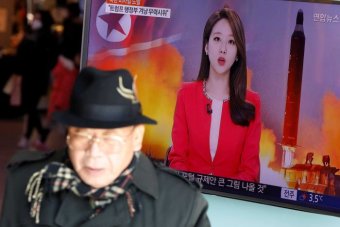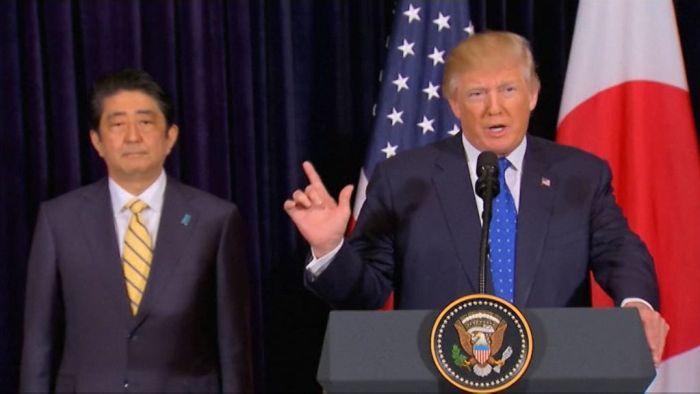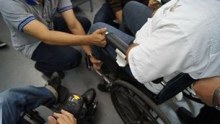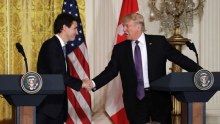North Korea 'test fires missile in show of force' as Donald Trump meets with Japanese Prime Minister
Updated
North Korea has fired a ballistic missile in the first such test since US President Donald Trump took office.
The missile is believed to have splashed down into the sea between the Korean Peninsula and Japan, South Korean officials said.
There was no immediate confirmation from the North, which recently warned it was ready to test its first intercontinental ballistic missile (ICBM).
The launch marks the first test of Mr Trump's vow to get tough on a North Korean regime, which last year tested nuclear devices and ballistic missiles at an unprecedented rate in violation of United Nations sanctions.
It also happened a day after Mr Trump held a summit meeting with Japanese Prime Minister Shinzo Abe and said he agreed to work to ensure a strong defence against North Korea's threat.
Mr Trump said late on Saturday (local time) that the United States stood fully behind Japan in the aftermath of North Korea's latest missile launch.
"I just want everybody to understand, and fully know, that the United States of America is behind Japan, our great ally, 100 per cent," Mr Trump told reporters alongside Mr Abe, who labelled the launch "absolutely unacceptable".
Australia calls on North Korea to end 'provocative behaviour'
A joint statement from Prime Minister Malcolm Turnbull and Foreign Minister Julie Bishop released on Sunday afternoon said the launch had prompted the consideration of additional sanctions against North Korea.
"Australia calls on North Korea to cease its provocative behaviour, abandon its nuclear and missile programs and engage constructively with the international community," the statement read.
"There is a pressing need to improve the welfare of North Korea's impoverished people, rather than divert resources to develop nuclear weapons and missiles."
A White House official said Mr Trump had been briefed on the missile launch, and the White House continued to monitor the situation.
In Washington, public affairs officers for the Defence Department and the State Department had no immediate comment on the report.
The Pentagon said the US Strategic Command had followed the medium or intermediate range missile throughout its trajectory into the sea of Japan and determined it did not pose a threat to North America.
 Photo:
Donald and Melania Trump hosted Shinzo and Akie Abe at Mr Trump's Mar-a-Lago estate in Palm Beach, Florida. (Reuters: Carlos Barria)
Photo:
Donald and Melania Trump hosted Shinzo and Akie Abe at Mr Trump's Mar-a-Lago estate in Palm Beach, Florida. (Reuters: Carlos Barria)
'We cannot accept these provocations'
The missile was launched from an area named Panghyon in North Korea's western region just before 8:00am (local time) and flew about 500 kilometres, the South's Office of the Joint Chiefs of Staff said in statements — the same place officials said the North test launched its powerful midrange Musudan missile on October 15 and 20.
"Our assessment is that it is part of a show of force in response to the new US administration's hardline position against the North," the office said.
Japan's chief cabinet secretary, Yoshihide Suga, said the missile had apparently landed in the Sea of Japan but not within the country's exclusive economic zone.
South Korea and Japan both condemned the launch.
"We can absolutely not accept these continued provocations by North Korea, and have protested strongly to them," Mr Suga said.
US National Security Adviser Michael Flynn and his South Korean counterpart Kim Kwan-jin spoke by phone and agreed their nations would explore all possible options to rein in North Korean provocations, South Korea's presidential Blue House said.
A US official said the Trump administration would press China to do more to control North Korea.
China is North Korea's main ally but has been frustrated by Pyongyang's repeated provocations, although it bristles at pressure from Washington and Seoul to rein in the North and its young leader, Kim Jong Un.
China's foreign ministry did not immediately respond to a request for comment on Sunday morning.
North Korea stepping up weapon tests
The North conducted two nuclear tests and a slew of rocket launches last year in continued efforts to expand its nuclear weapons and missile programs.
 Photo:
North Korea began stepping up the frequency of its rocket and nuclear tests last year. (Reuters: KCNA, file photo)
Photo:
North Korea began stepping up the frequency of its rocket and nuclear tests last year. (Reuters: KCNA, file photo)
It tried to launch a Musudan eight times last year, but most attempts failed.
One launch that sent a missile 400 kilometres — more than half the distance to Japan — was considered a success by officials and experts in the South and the United States.
Korean leader Kim Jong Un said in his New Year's address that the country had reached the final stages of readiness to test an ICBM, which would be a major step forward in its efforts to build a credible nuclear threat to the United States.
His comments prompted a vow of an "overwhelming" response from US Defence Secretary James Mattis, when he travelled to South Korea earlier this month.
ICBMs have a minimum range of about 5,500km, but some are designed to travel 10,000km or more.
Though Pyongyang has been relatively quiet about the transfer of power to the Trump administration, its state media has repeatedly called for Washington to abandon its "hostile policy" and vowed to continue its nuclear and missile development programs until the US changes its diplomatic approach.
Reuters/AP
Topics: unrest-conflict-and-war, world-politics, korea-republic-of, korea-democratic-people-s-republic-of
First posted









